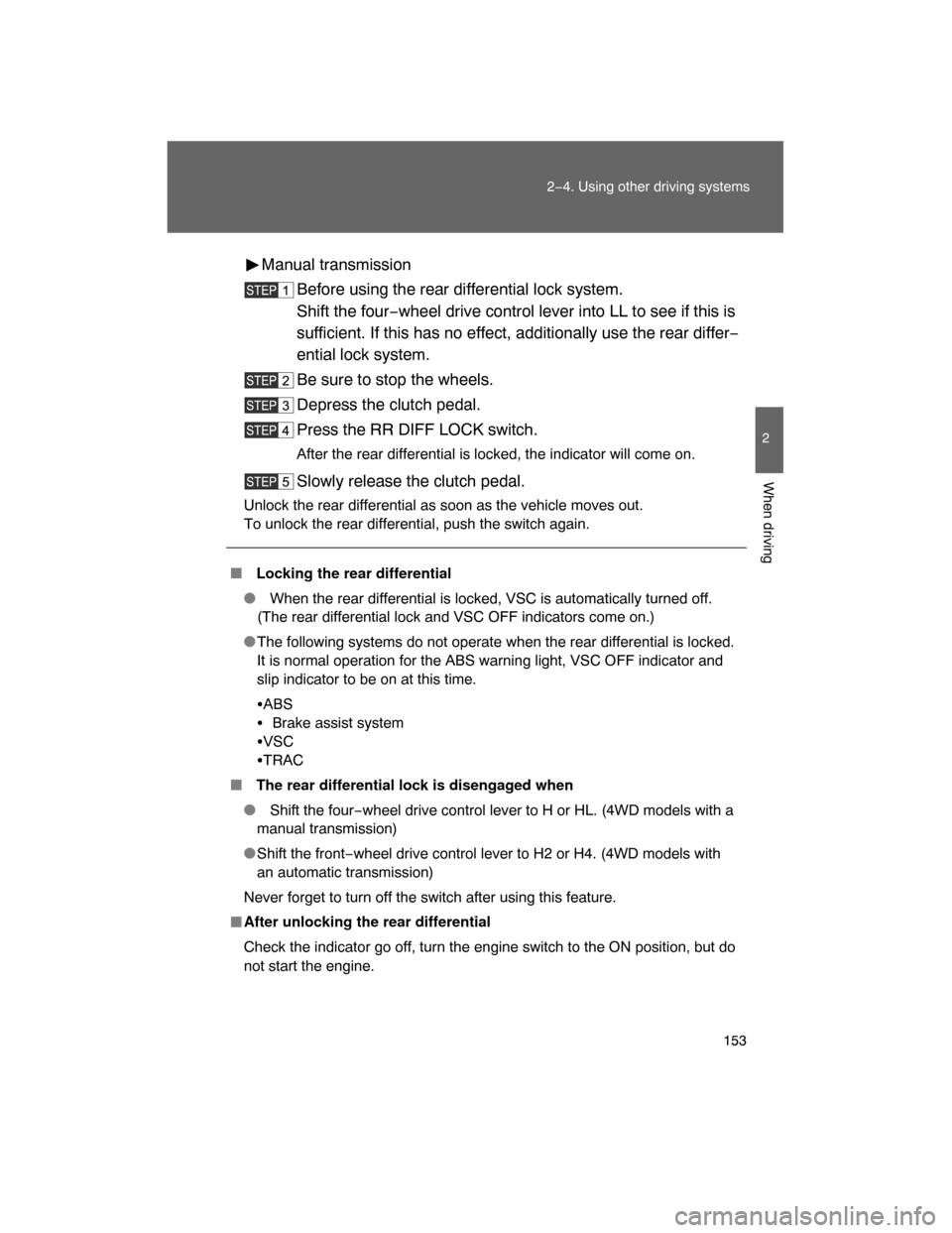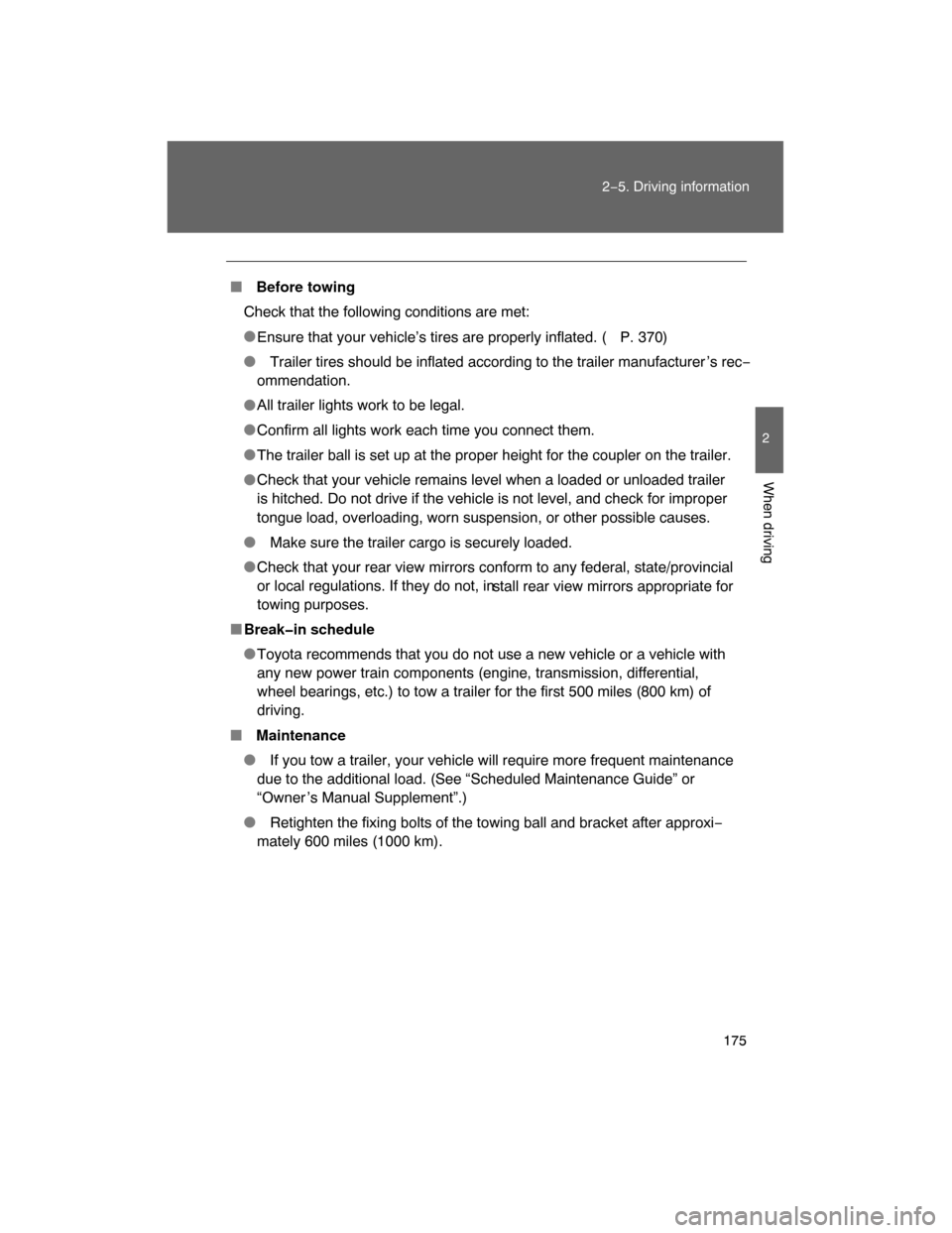Page 138 of 400
140 2−4. Using other driving systems
The distance and buzzer
When a sensor detects an obstacle, the buzzer sounds. � Intuitive parking assist switch
ON/OFF
When on, the buzzer sounds
to inform the driver that the
system is operational. At this
time, the indicator light will
come on.
Press the button to switch the
ON/OFF mode.
Distance shown
as4.9 to 3.3 ft.
(150 to 100 cm)3.3 to 1.6 ft.
(100 to 50 cm)1.6 ft.
(50 cm)
Buzzer Medium Fast Continuous
Page 140 of 400

142 2−4. Using other driving systems
� Sensor detection information
� Certain vehicle conditions and the surrounding environment may affect
the ability of a sensor to correctly detect an obstacle. Particular instances
where this may occur are listed below.
�There is dirt, snow or ice on a sensor.
�A sensor is frozen.
�A sensor is covered in any way.
�The vehicle is leaning considerably to one side.
�On an extremely bumpy road, on an incline, on gravel, or on grass.
�The vicinity of the vehicle is noisy due to vehicle horns, motorcycle
engines, air brakes of large vehicles, or other loud noises producing
ultrasonic waves.
�There is another vehicle equipped with parking assist sensors in the
vicinity.
�A sensor is coated with a sheet of spray or heavy rain.
�The vehicle is equipped with a fender pole or radio antenna.
�A bumper or sensor receives a strong impact.
�The vehicle is approaching a tall or right−angled curb.
�In harsh sunlight or intense cold weather.
�The area directly under the bumpers is not detected.
Objects lower than the sensors or thin stakes etc. may be detected ini−
tially, but as they draw closer, they may cease to be detected.
�A towing hitch is mounted to the vehicle.
�A non−genuine Toyota suspension (lowered suspension etc.) is
installed.
In addition to the examples above, there are instances in which, because of
their shapes, signs and other objects may be judged by a sensor to be closer
than they are.
� The shape of the obstacle may prevent a sensor from detecting it. Pay
particular attention to the following obstacles:
�Wires, fences, ropes, etc.
�Cotton, snow and other materials that absorb radio waves
�Sharply−angled objects
�Low obstacles
�Tall obstacles with upper sections projecting outwards in the direction
of your vehicle
Page 151 of 400

153
2−4. Using other driving systems
2
When driving
Manual transmission
Before using the rear differential lock system.
Shift the four−wheel drive control lever into LL to see if this is
sufficient. If this has no effect, additionally use the rear differ−
ential lock system.
Be sure to stop the wheels.
Depress the clutch pedal.
Press the RR DIFF LOCK switch.
After the rear differential is locked, the indicator will come on.
Slowly release the clutch pedal.
Unlock the rear differential as soon as the vehicle moves out.
To unlock the rear differential, push the switch again.
� Locking the rear differential
� When the rear differential is locked, VSC is automatically turned off.
(The rear differential lock and VSC OFF indicators come on.)
�The following systems do not operate when the rear differential is locked.
It is normal operation for the ABS warning light, VSC OFF indicator and
slip indicator to be on at this time.
�ABS
�Brake assist system
�VSC
�TRAC
� The rear differential lock is disengaged when
� Shift the four−wheel drive control lever to H or HL. (4WD models with a
manual transmission)
�Shift the front−wheel drive control lever to H2 or H4. (4WD models with
an automatic transmission)
Never forget to turn off the switch after using this feature.
�After unlocking the rear differential
Check the indicator go off, turn the engine switch to the ON position, but do
not start the engine.
Page 154 of 400

156
2−4. Using other driving systems
Driving assist systems
When VSC/TRAC are operating
If the vehicle is in danger of slip−
ping, or if the rear wheels (2WD
models) or all wheels (4WD
models) spin, the indicator light
flashes to indicate that VSC/
TRAC have been engaged.
A buzzer (intermittent) sounds to
indicate that VSC is operating. To help enhance driving safety a nd performance, the following sys�
tems operate automatically in res
ponse to various driving situations.
Be aware, however, that these systems are supplementary and
should not be relied upon too h
eavily when operating the vehicle.
� ABS (Anti�lock Brake System)
Restrains the vehicle from slipping when driving on slick road surfaces
or in the event of sudden braking.
� Brake Assist
Generates an increased level of braking force after the brake pedal is
depressed, when the system detects a panic stop situation.
� VSC (Vehicle Stability Control)
Helps the driver to control skidding when swerving suddenly or turning
on slippery road surfaces.
� TRAC (Traction Control)
Maintains drive power and prevents the rear wheels (2WD models) or
all wheels (4WD models) from spinning when starting the vehicle or
accelerating on slippery roads.
Page 156 of 400
158 2−4. Using other driving systems
� Sounds and vibrations caused by
the ABS, TRAC, VSC and brake
assist system
�A sound may be heard from the engine compartment when the engine is
started or just after the vehicle begins to move. This sound does not indi−
cate that a malfunction has occurred in any of these systems.
� Any of the following conditions may occur when the above systems are
operating. None of these indicates that a malfunction has occurred.
�Vibrations may be felt through the vehicle body and steering.
�A motor sound may be heard after the vehicle comes to a stop.
�The brake pedal may pulsate slightly after the ABS is activated.
�The brake pedal may move down slightly after the ABS is activated.
� If the brake system overheats
TRAC will cease operation and a buzzer will sound to alert the driver. Stop
the vehicle in a safe place. (There is
no problem with continuing normal driv−
ing.)
Page 172 of 400
174 2−5. Driving information
Selecting trailer ball
Use the correct trailer ball for your application.
Trailer ball load rating
Matches or exceeds the gross
trailer weight rating of the trailer.
Ball diameter
Matches the size of the trailer
coupler. Most couplers are
stamped with the required trailer
ball size.
Shank length
Protrudes beyond the bottom of
the lock washer and nut at least 2
threads.
Shank diameter
Matches the ball mount hole
diameter size.
Connecting trailer lights
Use the wire harness stored in
the rear end underbody.
Page 173 of 400

175
2−5. Driving information
2
When driving
� Before towing
Check that the following conditions are met:
�
Ensure that your vehicle’s tires are properly inflated. ( P. 370)
� Trailer tires should be inflated according to the trailer manufacturer ’s rec−
ommendation.
�All trailer lights work to be legal.
�Confirm all lights work each time you connect them.
�The trailer ball is set up at the proper height for the coupler on the trailer.
�Check that your vehicle remains level when a loaded or unloaded trailer
is hitched. Do not drive if the vehicle is not level, and check for improper
tongue load, overloading, worn suspension, or other possible causes.
� Make sure the trailer cargo is securely loaded.
�Check that your rear view mirrors conform to any federal, state/provincial
or local regulations. If they do not, in
stall rear view mirrors appropriate for
towing purposes.
�Break�in schedule
�Toyota recommends that you do not use a new vehicle or a vehicle with
any new power train components (engine, transmission, differential,
wheel bearings, etc.) to tow a trailer for the first 500 miles (800 km) of
driving.
� Maintenance
� If you tow a trailer, your vehicle will require more frequent maintenance
due to the additional load. (See “Scheduled Maintenance Guide” or
“Owner ’s Manual Supplement”.)
� Retighten the fixing bolts of the towing ball and bracket after approxi−
mately 600 miles (1000 km).
Page 174 of 400

176 2−5. Driving information
CAUTION
� To avoid accident or injury
� The total trailer weight (trailer weight plus the weight of cargo) must not
exceed 5000 lb. (2265 kg)
�If a trailer and cargo weight over 2000 lb. (907 kg), use a sway control
device with sufficient capacity.
� The gross combined weight (sum of your vehicle weight plus its load and
the total trailer weight) must not exceed the following.
2WD models
9200 lb. (4173 kg)
4WD models
9500 lb. (4309 kg)
�Do not exceed the trailer hitch assembly weight, gross vehicle weight,
gross axle weight and trailer tongue load capacities.
� Never load more weight in the back than in the front of the trailer. About
60% of the load should be in the front half of the trailer, and the remaining
40% in the rear.
� The tow hitch receiver installed on your vehicle must never be used on
another vehicle.
�Hitches
�If you wish to install a trailer hitch, your Toyota dealer should be consulted.
�Use only a hitch that conforms to the total trailer weight requirement.
�Follow the directions supplied by the hitch manufacturer.
�Lubricate the hitch ball with a light coat of grease.
�
Remove the trailer hitch whenever y ou are not towing a trailer to reduce
the possibility of additional damage caused by the hitch if your vehicle is
struck from behind.